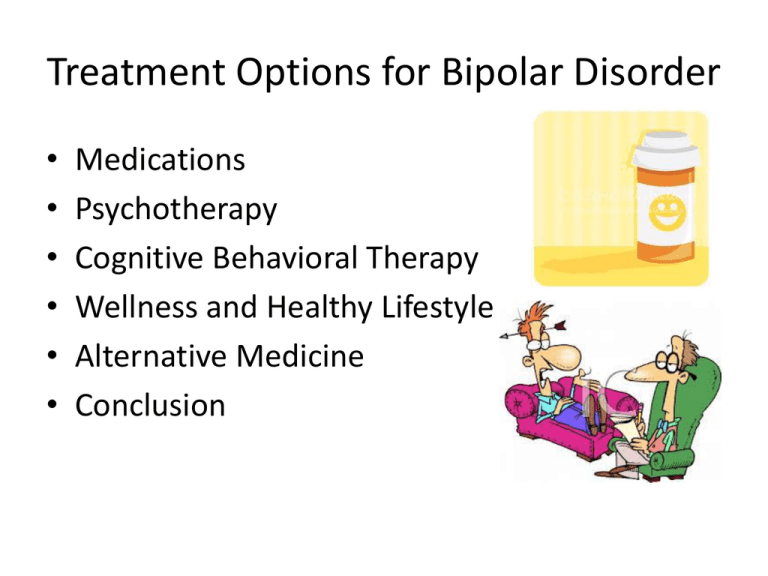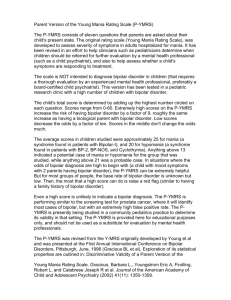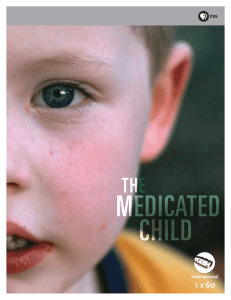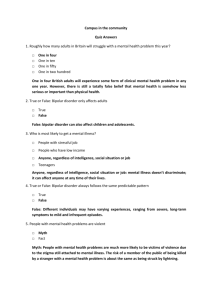Project Presentaion - Ronda McCoy E
advertisement

Treatment Options for Bipolar Disorder • • • • • • Medications Psychotherapy Cognitive Behavioral Therapy Wellness and Healthy Lifestyle Alternative Medicine Conclusion Medications • Treatment of bipolar disorder involves three therapeutic domains: acute mania, acute depression, and maintenance. • Lithium • Antiepileptic drugs: divalproex, carbamazepine, and lamotrigine • Antipsychotic drugs: olanzapine, risperidone, and quetiapine • Used alone or in combination, are increasingly being used successfully to treat acute mania and to maintain mood stability (McIntyre, 2004). Psychotherapy and Cognitive Behavioral Therapy • When these medications are used with psychotherapy the treatment is somewhat successful. • Additionally, when medications, psychotherapy, and cognitive therapy (teaching one what their BD means and how it affects them) there is more success. • Furthermore, when medications, therapies, and teaching cognitive therapies in prevention for relapse are included with health and wellness plans, there is still more success. • Including all of these things produces a client-centered therapeutic atmosphere. Health and Wellness • A study included thirty-two patients diagnosed with bipolar disorder, and treated them with six wellness strategies: • 1) Sleep, rest, exercise and diet • 2) Ongoing monitoring (Psychotherapy) • 3) Enacting a plan (Psycotherapy) • 4) Reflective and meditative practices • 5) Understanding BD and educating others (Cognitive Therapy) • 6) Connecting with others • The study increased the overall health and wellness of each patient . (Suto, 2010) Why is health so important? • 84% of all those with bipolar disorder are either overweight or obese (McElroy, 2002). • Physical activity and exercise have been proven to aid in treatment with bipolar patients as a form of therapy, and it is a bonus treatment for their health: – Raising serotonin levels decreases the chances of depression or mania because it acts as a regulatory mechanism (Felicity, 2007). – Exercise increases neurogenesis and decreases allostatic load which is activation of the body’s stress response that can be damaging in the long run (Sylvia, 2010). – Aerobic exercise has a tremendous benefit to neurocognitive capabilities besides stabilizing bipolar episodes, it also decreases memory loss and allows for better cognitive function. (And that’s just in the brain (Kucyi, 2010). There are many other positive side-effects from exercising that are good for the body.) Complimentary and Alternative Medicine • Studies using omega-3 fatty acids, acupuncture, aromatherapy, massage therapy, and yoga as treatments for bipolar disorder provide little evidence regarding any benefits because the conclusions are either inconsistent or the benefits are almost entirely lacking (Brown, 2005). • There is sufficient evidence to consider Sudarshan Kriya Yoga (SKY) to be beneficial for stress, anxiety, or mood disorders. However, yoga should be used with caution in bipolar I disorder patients or unstable rapid cyclers. Some breathing techniques can induce mania, and some bipolar patients may overuse the practices for self-stimulation and inadvertently trigger psychosis. (Andreescue, 2008) Conclusion • When medications, psychotherapy (with client-centered therapy), cognitive Therapy (including prevention for relapse), and a healthy lifestyle combine, it creates the most successful form of treatment for bipolar patients. References • • • • • • • • • • Alsuwaidan, M. T. (2009). Exercise and Bipolar Disorder: A Review of Neurobiological Mediators . Neuromolecular Medicine , 328-336. Andreescu, C. (2008). Complementary and alternative medicine in the treatment of bipolar disorder--A review of the evidence. Journal of Affective Disorders , 16-26. Brown, R. P. (2005). Sudarshan Kriya Yogic Breathing in the Treatment of Stress, Anxiety, and Depression: Part II— Clinical Applications and Guidelines. The Journal of Alternative and Complimentary Medicine , 711-717. Comer, R. J. (2011). Fundamentals of Abnormal Psychology sixth edition. New York: Worth Publishers. Felicity, N. (2007). The effects of physical activity in the acute treatment of bipolar disorder: A pilot study. Journal of Affective Disorders , 259-262. Kucyi, A. (2010). Aerobic Physical Exercise as a Possible Treatment for Neurocognitive Dysfunction in Bipolar Disorder. Postgraduate Medicine the Rapid Peer-Reviewed Journal for Physicians , 58-64. McIntyre, R. S. (2004). Treating bipolar disorder. Evidence-based guidelines for family medicine. The Official Journal of the College of Family Physicians of Canada , 388-394. McElroy, S.L. (2002). Correlates of overweight and obesity in 644 patients with bipolar disorder. The Journal of Clinical Psychiatry , 207-213. Suto, M. (2010). What works for people with BipolarDisorder ? Tips from the experts. Journal of Affective Disorders , 76-84. Sylvia, L. G. (2010). Exercise Treatment for Bipolar Disorder: Potential Mechanisms of Action Mediated through Increased Neurogenesis and Decreased Allostatic Load. Psychotherapy and Psychosomatics , 87-96.






